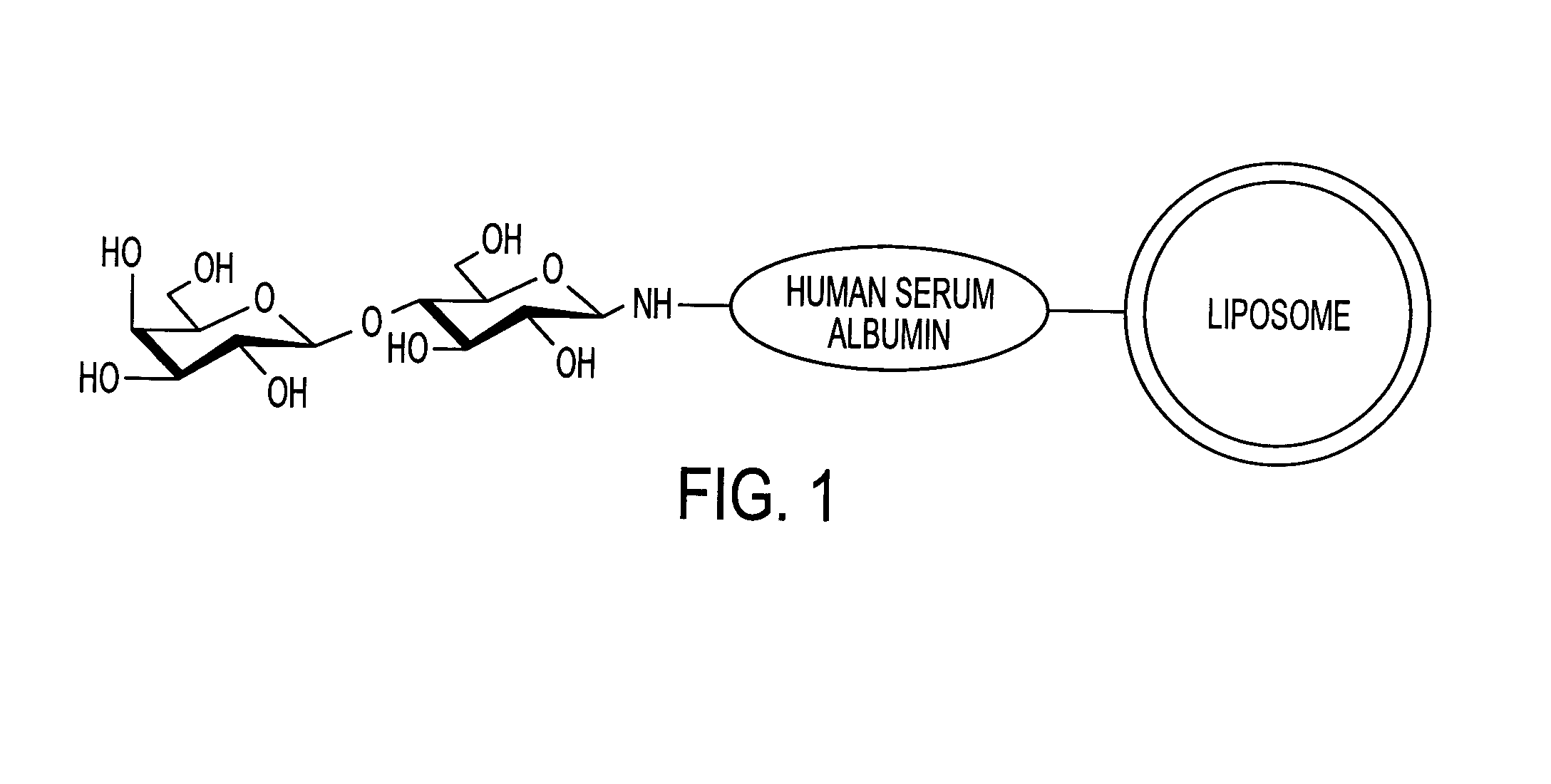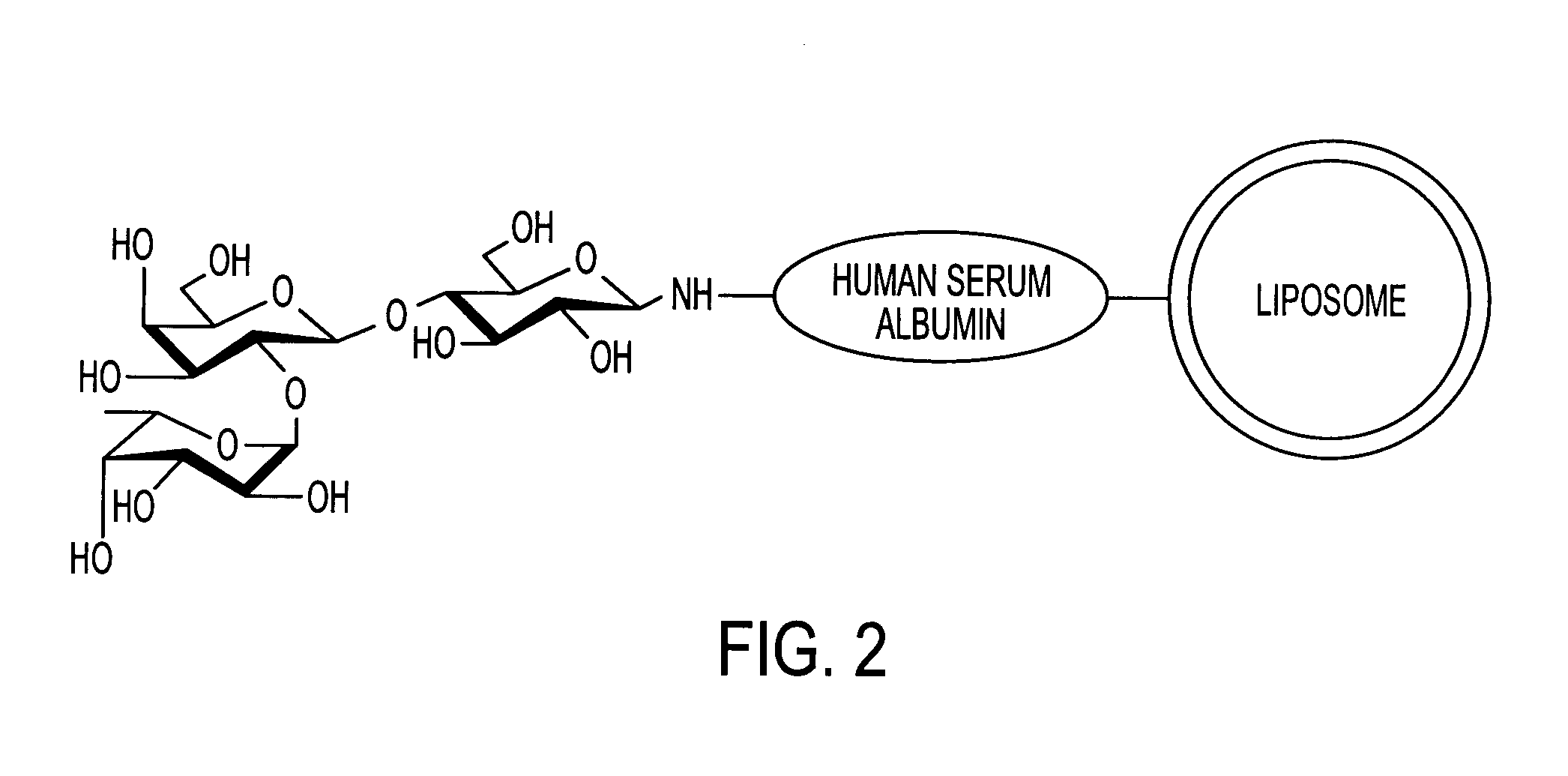Sugar-modified liposome and products comprising the liposome
a technology of sugar-modified liposomes and liposomes, which is applied in the field of sugar-modified liposomes and products comprising the liposomes, can solve the problems of undesirable side effects, increased incidence and morbidity of cancer, and progressive aging of the population, and achieve excellent absorption qualities
- Summary
- Abstract
- Description
- Claims
- Application Information
AI Technical Summary
Benefits of technology
Problems solved by technology
Method used
Image
Examples
example 1
Preparation of Liposomes
[0072]Liposomes were prepared through an improved type of cholate dialysis based on a previously reported method (Yamazaki, N., Kodama, M. and H. -J. Gabius. Methods Enzymol. 242:56–65 (1994)). More specifically, 46.9 mg of sodium cholate was added to 45.6 mg of lipid mixture consisting of dipalmitoylphosphatidylcholine, cholesterol, dicetylphosphate, ganglioside and dipalmitoylphosphatidylethanolamine at a mole ratio of 35:40:5:15:5, respectively, and the lipid mixture was dissolved in 3 ml of chloroform / methanol solution. The solution was then evaporated, and the resulting deposit was dried in vacuo to obtain a lipid membrane. The obtained lipid membrane was suspended in 3 ml of a TAPS buffer solution (pH 8.4), and was subjected to a supersonic treatment to obtain a clear micelle suspension. Then, this micelle suspension was subjected to ultrafiltration by using a PM 10 membrane (Amicon Co., USA) and a PBS buffer solution (pH 7.2) to prepare 10 ml of a unif...
example 2
Hydrophilization of Lipid Membrane Surface of Liposomes
[0073]10 ml of the liposome solution prepared in Example 1 was subjected to ultrafiltration by using an XM 300 membrane (Amicon Co., USA) and a CBS buffer solution (pH 8.5) to adjust the pH of the solution to 8.5. Then, 10 mg of bis (sulfosuccinimidyl) suberate (BS3; Pierce Co., USA) crosslinking reagent was added to the liposome solution. The obtained solution was stirred at 25° C. for 2 hours, and subsequently stirred at 7° C. for one night to complete the reaction between the BS3 and the dipalmitoylphosphatidyletanolamine of the lipid on the liposome membrane. This liposome solution was then subjected to ultrafiltration by using an XM 300 membrane and a CBS buffer solution (pH 8.5). Then, 40 mg of tris (hydroxymethyl) aminomethane dissolved in 1 ml of CMS buffer solution (pH 8.5) was added to 10 ml of the liposome solution. The obtained solution was stirred at 25° C. for 2 hours, and stirred at 7° C. for one night to complete...
example 3
Bonding of Human Serum Albumin (HSA) to Membrane Surface of Liposomes
[0074]Human serum albumin (HSA) was bonded to the membrane surface of the liposome through a coupling reaction method based on a previously reported method (Yamazaki, N., Kodama, M. and H. -J. Gabius. Methods Enzymol. 242:56–65 (1994)). More specifically, the reaction was carried out through a two-stage reaction method. That is, 43 mg of sodium metaperiodate dissolved in 1 ml of TAPS buffer solution (pH 8.4) was added to 10 ml of the liposome obtained in Example 2, and the obtained solution was stirred at room temperature for 2 hours to periodate-oxidize the ganglioside on the membrane surface of the liposome. Then, the solution was subjected to ultrafiltration by using an XM 300 membrane and a PBS buffer solution (pH 8.0) to obtain 10 ml of oxidized liposome. 20 mg of human serum albumin (HSA) was then added to the liposome solution, and the obtained solution was stirred at 25° C. for 2 hours. Then, 100 μl of 2M N...
PUM
| Property | Measurement | Unit |
|---|---|---|
| pH | aaaaa | aaaaa |
| size | aaaaa | aaaaa |
| pH | aaaaa | aaaaa |
Abstract
Description
Claims
Application Information
 Login to View More
Login to View More - R&D
- Intellectual Property
- Life Sciences
- Materials
- Tech Scout
- Unparalleled Data Quality
- Higher Quality Content
- 60% Fewer Hallucinations
Browse by: Latest US Patents, China's latest patents, Technical Efficacy Thesaurus, Application Domain, Technology Topic, Popular Technical Reports.
© 2025 PatSnap. All rights reserved.Legal|Privacy policy|Modern Slavery Act Transparency Statement|Sitemap|About US| Contact US: help@patsnap.com



